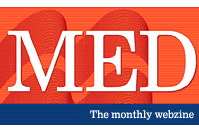
FROM THE EDITOR
 In
this Issue In
this Issue
 Contributors Contributors
 Letters
to the Editor Letters
to the Editor
 Write
to Us Write
to Us
 Spread
the Word Spread
the Word
 Back
Issues Back
Issues
 Index Index
FEATURE
 A
wish beyond words A
wish beyond words
Richard Cauldwell calls for
a novel way of teaching
listening skills
COLUMNS
 Language
Interference Language
Interference
Borrowings and
false friends between
Russian and English
 Focus
on Language Focus
on Language
Awareness:
Introduction
Numbers
Writing and pronouncing
numbers
UK version ¦
US version
 New
word of the month New
word of the month
New words in sport
 Top
Tips for the CD-ROM Top
Tips for the CD-ROM
MED CD and functional
language
 onestopenglish.com onestopenglish.com
|
This article gives information about how
to say and write numbers in English. It also outlines some of the differences
in the use of numbers between American and British English.
•
Numbers from One to a Million
• Ways of Saying the
Number 0
• Fractions and Decimals
• Writing Periods and
Commas in Numbers
• Dates
• Money
• Phone Numbers
• Route and Road Numbers
Numbers
from One to a Million
| one |
| twenty-one |
| eighty-four |
| a/one hundred |
| two hundred |
American English four hundred thirty-two
British English four hundred and thirty-two |
| a/one thousand |
| a/one thousand and one |
| one thousand one hundred/eleven hundred
|
| two thousand |
American English two thousand nine hundred
thirty-two
British English two thousand nine hundred and thirty-two |
three thousand one hundred
American English also thirty-one hundred |
| a/one hundred thousand |
| a/one million |
You can say a hundred and fifty (150), but NOT
two thousand a hundred and fifty
(2,150). Say two thousand one hundred and fifty. People often use
a instead of one in conversation, but it is better to use
one in technical contexts.
top
Ways
of Saying the Number 0
You can pronounce 0 like the letter o, when you are giving
a series of numbers such as a credit card number or a flight number. (See
also the sections on Phone Numbers and Road
Numbers).
Say oh in giving the name of a year, such as 1904 ("nineteen
oh four").
American English: Say zero.
British English: Say nought or zero.
American English: Say zero to refer to 0° Fahrenheit.
British English: Say zero to refer to freezing point (0° Celsius
or -32° Fahrenheit).
American English: Say zero or nothing.
British English: Say nil.
In tennis: Say love.
top
Fractions
and Decimals
| a half |
| two and a half |
| a quarter |
three quarters
American English also three fourths |
American English
zero point five
British English nought point five |
| two point five |
American English zero point two five
British English nought point two five |
American English zero point seven five
British English nought point seven five |
top
Writing
Periods and Commas in Numbers
Use a period (.) to separate the main part of a
number from the decimal part (the part that is less than 1). 2.031
means "two point zero three one".
Say point to refer to the period. You can use a
comma (,) in large numbers to separate the hundreds, thousands,
and millions. 2,031
means "two thousand and thirty-one". In British English, spaces
are sometimes used instead of commas (2 031).
Remember:
Speakers of some other languages use (.) and (,) the other way around.
top
Dates
American English: Write June 3/June 3rd.
Say 'June third'.
British English: Write 3 June/3rd June/June 3/June
3rd. Say 'the third of June' or 'June the third'.
3/6 (or 03/06) means March 6 in American
English, and 3 June in British English. British and American speakers
put the month and day in different orders.
| ten sixty-six |
| sixteen oh five |
| seventeen seventy-six |
| nineteen hundred |
| nineteen ninety-nine |
| (the year) two thousand |
two thousand and one
American English also two thousand one |
top
Money
These are some common ways of saying amounts of money.
American speakers talk about money in the following way:
| forty-five cents |
| a dollar |
| a dollar fifty |
| two dollars |
| two dollars and fifty-five cents or two
fifty-five |
| a/one hundred dollars |
| a/one hundred fifteen dollars and ninety-nine
cents or a/one hundred fifteen, ninety-nine |
| two hundred (and) fifty dollars or two
fifty dollars |
| two thousand six hundred eighty-two dollars
and seventy-four cents |
British speakers talk about money in the following way:
| forty-five p or forty-five pence |
| one pound |
| one pound fifty or one fifty |
| two pounds |
| two pounds fifty-five or two fifty-five |
| a/one hundred pounds |
| a hundred and fifteen pounds, ninety-nine
p/pence |
| two hundred and fifty pounds or two fifty
pounds |
| two thousand six hundred and eighty-two
pounds, seventy-four p/pence |
top
Phone Numbers
Say phone numbers as series of numbers, with pauses between
the groups of numbers. For example, say 555-8473 as five five five
eight four seven three or five five five, eighty-four seventy-three;
and say (555) 876-0934 as five five five, eight seven six,
oh nine three four.
American English: People often say "area code" before
the first part of the number, which represents the area where they live;
for example, area code five five five, six three two, nine eight two
one (=(555) 632-9821).
British English: For phone numbers like 5155, people
often say five one double five. For numbers like 1555, people often
say one treble five or one five double five.
top
Route and
Road Numbers
These are some common ways of saying the numbers of routes
or roads.
| American English |
| one oh one |
| two eighty |
| highway one |
/a /
five, interstate five /
five, interstate five |
| British English |
| /em/ one |
| /em/ sixty-two |
/e /
five /
five |
/e /
thirty-four /
thirty-four |
/bi /
one five six two /
one five six two |
top
|





